Understanding Snowshoe Cat Behavior
Snowshoe cats are unique breeds known for their distinctive appearance and playful demeanor. However, like all cats, they can exhibit behavioral issues at times. Understanding their unique behavior is key to effectively resolving problems. This breed is affectionate and social, enjoying interaction with their owners. When they display unwanted behaviors, it can often be attributed to stress, boredom, or unmet needs. Identifying the root cause of these behaviors involves observing your pet in different situations. Are they scratching furniture out of boredom or trying to gain attention? The environment plays a pivotal role; ensuring your Snowshoe cat has engaging toys, safe zones, and regular interaction can significantly mitigate these problems. Additionally, providing a structured routine helps them feel secure. Environmental enrichment—like scratching posts and climbing trees—keeps these clever cats mentally stimulated. Always remember, punishment is ineffective; instead, positive reinforcement encourages desired behaviors. When faced with difficulties, patience and empathy are necessities in managing their actions. Consultation with a veterinarian or behavioral expert is often beneficial for severe issues, and early intervention will ensure a harmonious household.
Behavioral issues in Snowshoe cats can manifest in various forms. Common challenges include inappropriate scratching, litter box avoidance, and excessive vocalization. To tackle inappropriate scratching, observe your cat’s preferences for specific materials. Provide appropriate scratching surfaces, like vertical scratching posts, which can redirect their natural tendencies effectively. If your cat refuses to use the litter box, several factors could be at play. Ensure the litter is clean, the box is in a quiet area, and try different types of litter to find what suits them best. Excessive vocalization might indicate a desire for attention or an underlying medical issue. Consider rewarding quiet behavior with affection or treats to reinforce peace in your home. It’s essential to maintain a calm atmosphere and avoid reacting adversely to your cat’s outbursts, as this can exacerbate the problem. Remember, every Snowshoe is unique, and their reactions can vary significantly. Understanding your pet’s needs and personality is crucial for creating a supportive environment.
Promoting a Positive Environment
Creating a positive living environment is paramount in addressing behavioral issues in Snowshoe cats. Start by providing dedicated playtime every day to channel their energy constructively. This can include interactive games, toys that mimic prey, or even engaging them in puzzle feeders that challenge their intellect. Regular play helps alleviate boredom and reduces the chances of destructive behaviors. Additionally, establishing a cozy, safe nook within your home will make your Snowshoe cat feel secure. Cats are territorial, and having their personal space helps reduce stress levels. This area should be equipped with soft bedding, familiar scents, and toys to encourage relaxation. Furthermore, introducing new items gradually, like new furniture or cats into the household, will help them adjust without anxiety. Maintain a consistent feeding and activity schedule to enhance predictability. Being attentive to your cat’s mood shifts can offer insight into their mental state, allowing for quick adjustments to their routine when necessary. If anxiety persists, consider consulting a veterinarian, as they can recommend behavioral therapy options or even medication to improve your cat’s quality of life.
Socialization is an integral part of a Snowshoe cat’s development and behavioral adjustment. Early exposure to different people, pets, and environments can greatly affect how well your cat adapts later. When introducing your Snowshoe to new experiences, proceed slowly and with patience. Use positive reinforcement techniques, like offering treats or praise, to encourage them during these new encounters. If your cat is shy, allow them to approach at their own pace. Avoid forcing interactions, as this can create fear and stress. Familiarizing your Snowshoe progressively with household members and any other pets can prevent potential territorial behaviors. Remember that not all cats will enjoy being held or cuddled; it’s important to respect their boundaries. Setting up ‘safe zones’ for your cat within your home can help them retreat when overwhelmed. Monitoring their socialization experiences helps you gauge their comfort levels and offers opportunities for positive interactions. Proactively nurturing this aspect of their life will result in a balanced, confident Snowshoe cat that thrives in diverse company.
Understanding Health-Related Issues
Sometimes, behavioral issues may stem from underlying health problems, particularly in Snowshoe cats. Issues like urinary tract infections or pain associated with arthritis can lead to changes in behavior or increase aggression. Regular veterinary check-ups are vital, as they help identify potential medical concerns early on before they lead to behavioral problems. Discuss any observed changes in your cat’s behavior with your veterinarian, as they can suggest necessary tests, diagnoses, or treatments. Attention to diet is also critical; a high-quality, balanced diet contributes to overall health and well-being. Additionally, hydration is key, especially for urinary issues; provide fresh, clean water and consider wet food options. If your Snowshoe cat is older, they may require a specialized diet to minimize serious health problems. Healthy weight management prevents obesity-related issues, which can affect behavior significantly. By prioritizing their health needs, you’ll be ensuring a happier and more contented cat, likely to exhibit fewer behavioral issues. Always approach any changes in behavior with a holistic view, considering both behavioral and health aspects.
The use of positive reinforcement is one of the most effective techniques for managing behavioral issues in Snowshoe cats. Rewarding desirable behaviors with treats, affection, or praise encourages your cat to repeat them while helping to build trust between you and your pet. When dealing with negative behaviors, instead of punishing your Snowshoe, redirect their attention to a positive outlet. For instance, if your cat begins to scratch furniture, redirect them to their scratching post and reward them when they use it appropriately. Consistency is vital; every family member should follow the same rules to prevent confusion. Keeping training sessions short and fun ensures that both you and your cat remain engaged. Practicing patience during this process is essential as behavioral changes can take time. Observing your Snowshoe’s reactions to different incentives will allow you to tailor your approach to what motivates them best. Documenting their progress can also be beneficial, providing insight into what works well and what methods need adjustment. With commitment and care, behavioral modifications can lead to a more peaceful living environment.
Seeking Professional Help
While many behavioral issues can be resolved with time and patience, some situations may necessitate professional guidance. If your Snowshoe exhibits aggressive behavior, extreme anxiety, or other severe issues, seeking help from a cat behaviorist or a veterinarian is crucial. Professionals can evaluate your cat’s behaviors in-depth and provide tailored strategies based on their expertise. Additionally, workshops or training classes led by accredited trainers can offer techniques and support for you as an owner. Engaging in group training sessions can also foster a sense of community and increase your understanding of feline behaviors. When consulting professionals, provide them with as much detail as possible about your cat’s habits and environment to facilitate effective advice. Often, they may recommend behavioral modification plans which include daily exercises and socialization tips tailored to your Snowshoe. Understanding and improving your cat’s behavior enhances the bond between owner and pet. Remember, early intervention is vital to resolving serious behavior issues, so don’t hesitate to reach out for help when needed.
Caring for a Snowshoe cat involves commitment, patience, and an understanding of their unique needs. Behavioral issues can often be managed effectively through observation, positive reinforcement, and professional assistance when necessary. Creating a stimulating environment and addressing health concerns promptly plays a significant role. By prioritizing your Snowshoe’s mental and physical health, you improve not only their quality of life but also their interactions with you and others. Regular socialization, enriched routines, and understanding their behavior can greatly enhance their happiness. Always remember that every cat is an individual; what works for one may differ for another. Establishing trust forms the foundation of your relationship, proving essential when addressing behavioral challenges. Patience is key— changes won’t happen overnight, but your dedication will yield positive results in time. Celebrate the small victories along the way! In living with a Snowshoe cat, be prepared for a rewarding experience filled with love and affection. With the right approach, you can transform challenging behaviors into opportunities for deeper connection, ensuring that you’re not just a caregiver but a best friend to your feline companion.


